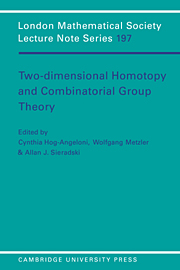Book contents
- Frontmatter
- Contents
- Editors' Preface
- Addresses of Authors
- I Geometric Aspects of Two-Dimensional Complexes
- II Algebraic Topology for Two Dimensional Complexes
- III Homotopy and Homology Classification of 2-Complexes
- IV Crossed Modules and Π2 Homotopy Modules
- V Calculating Generators of Π2
- VI Applications of Diagrams to Decision Problems
- VII Fox Ideals, N-Torsion and Applications to Groups and 3-Manifolds
- VIII (Singular) 3-Manifolds
- IX Cancellation Results for 2-Complexes and 4-Manifolds and Some Applications
- X J. H. C. Whitehead's Asphericity Question
- XI Zeeman's Collapsing Conjecture
- XII The Andrews-Curtis Conjecture and its Generalizations
- Bibliography
- Index
V - Calculating Generators of Π2
Published online by Cambridge University Press: 20 January 2010
- Frontmatter
- Contents
- Editors' Preface
- Addresses of Authors
- I Geometric Aspects of Two-Dimensional Complexes
- II Algebraic Topology for Two Dimensional Complexes
- III Homotopy and Homology Classification of 2-Complexes
- IV Crossed Modules and Π2 Homotopy Modules
- V Calculating Generators of Π2
- VI Applications of Diagrams to Decision Problems
- VII Fox Ideals, N-Torsion and Applications to Groups and 3-Manifolds
- VIII (Singular) 3-Manifolds
- IX Cancellation Results for 2-Complexes and 4-Manifolds and Some Applications
- X J. H. C. Whitehead's Asphericity Question
- XI Zeeman's Collapsing Conjecture
- XII The Andrews-Curtis Conjecture and its Generalizations
- Bibliography
- Index
Summary
This article discusses combinatorial geometric techniques that determine explicit generators for the second homotopy module of a 2-complex in terms of its cell structure. Applications of the techniques are also presented. The discussion focuses on the theory of pictures. Pictures have been used for many purposes; we shall be concerned only with their application to π2 calculations.
There are three sections, each of which is divided into several subsections. The first section provides an overview of the theory of pictures from a homotopytheoretic perspective. The second section deals with generalities related to the generation of π2. Some proofs are included in these first two sections, and there are several exercises. The third section is devoted to a summary description without proofs of various calculations and applications that have been obtained in the study of π2.
This paper may be taken as a companion and sequel to [Pr91], where pictures are treated within the purely combinatorial context of identity sequences.
The Theory of Pictures
As is customary, 2-complexes will be specified by means of group presentations. Let P = 〈x | r〉 be a presentation for a group G. Thus, G = F/N where F is the free group with basis x and N is the normal closure in F of the set r of (not necessarily reduced) words in x ∪ x-1. We allow the occurrence of trivial and repeated relators r ∈ r, so r should be treated as an indexed set of words.
- Type
- Chapter
- Information
- Two-Dimensional Homotopy and Combinatorial Group Theory , pp. 157 - 188Publisher: Cambridge University PressPrint publication year: 1993
- 38
- Cited by



